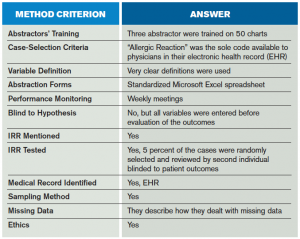
Case
A 44-year old woman with a peanut allergy accidently eats a cookie containing peanuts while attending her office holiday party. She arrives to the emergency department covered in hives, hypotensive, short of breath, and vomiting. She is diagnosed with anaphylaxis and treated successfully with epinephrine, nebulized beta-agonists, and H1 and H2 receptor antagonists as per the Guidelines for the Diagnosis and Management of Food Allergy in the United States.1
Explore This Issue
ACEP Now: Vol 33 – No 12 – December 2014Question
How long do you observe such patients, and what is the incidence of clinically important biphasic allergic reactions?
Background
Anaphylaxis is one of the most serious medical problems that can present to the emergency department. There are guidelines available to help clinicians assess and manage these life-threatening conditions.2
There is a fear in emergency medicine that patients can have a biphasic reaction. That is when the symptoms of anaphylaxis reoccur after being successfully treated.
Previous research has suggested the rate of biphasic reactions can be as high as 20 percent. This has led some experts to suggest observing patients with anaphylaxis for up to 24 hours.3 However, the literature shows that biphasic reactions can happen in a few minutes or even days later.
It is not practical to admit patients for up to one week of observation. So how long should you observe someone with an anaphylactic reaction, and what are the chances of a clinically important biphasic reaction?
Population: Adults (age >17 years) presenting to two urban EDs with allergic reactions
Intervention: Retrospective chart review
Control: N/A
Outcome: Primary (biphasic reaction) and secondary (mortality)
Excluded: <17 years old, primary diagnosis was asthma with allergy as secondary diagnosis, patient left ED prior to treatment, or patient had preexisting condition of angioedema
Authors Conclusions: “Among ED patients with allergic reactions or anaphylaxis, clinically important biphasic reactions and fatalities are rare. Our data suggest that prolonged routine monitoring of patients whose symptoms have resolved is likely unnecessary for patient safety.”
Key Results
There were a total of 428,634 ED visits over five years, with 2,323 (0.6 percent) considered allergic reactions and 496 (0.1 percent) classified as anaphylactic. Of these 2,819 patients, 185 had at least one subsequent visit for allergic symptoms (bounce back).
Pages: 1 2 3 | Single Page






2 Responses to “Biphasic Allergic Reactions: Observation, Treatment Guidelines”
January 26, 2015
biphasic allergic reactions… | DAILYEM[…] via this recent ACEP Now article by Dr. Milne […]
December 9, 2015
EllenHi Ken Milne, MD,
Thank you for sharing your knowledge on how to observe Biphasic Allergic Reactions and also for giving treatment guidelines for it.
This is really a great and helpful article.